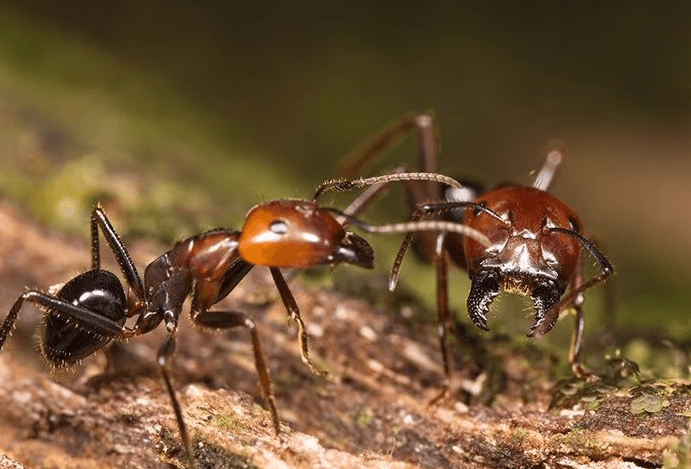
Bigheaded Ant Identification & Prevention In Nassau & Suffolk County, NY
What do bigheaded ants look like?
Latin name: Pheidole spp.
There are several species of bigheaded ants that can be found throughout the United States. They are in the genus Pheidole. Depending on the species, their color ranges from yellow to dark reddish-brown.
How did I get bigheaded ants?
Bighead ants are another of the invasive ant species and get their common name from their very big head in relationship to their overall body size. These ants are generally found nesting in soil that has been disturbed and under patios and yard debris located on the ground surfaces. Bighead ants are omnivores and will feed on insects and other arthropods, so large populations of insects attract bigheaded ants into yards. These pests then climb up the sides of homes, entering through cracks in walls or open windows. From here, they congregate in kitchens where food sources are plentiful. The pests seek out seeds, grease, sweets, and high-protein items.

How serious are bigheaded ants?
Bigheaded ant infestations cause minor damage to manicured lawns and may spread to packaged products and exposed fruits or meat, ruining pantry goods. The pests at times feed on houseplants and cause them to wilt. However, these ants do not cause significant damage to homes and do not usually bite unless disturbed.
How do I get rid of bigheaded ants?
Controlling these ants can involve several treatment methods. If part of the colony survives, the population can rebound. It is best to leave control to the pest control professional.
All State Pest Control is trained to help manage ants and similar pests. Since every building or home is different, your All State Pest Control technician will design a unique program for your situation.
Keeping ants out of homes and buildings is an ongoing process, not a one-time treatment. All State Pest Control’s exclusive A.I.M. solution is a continuing cycle of three critical steps — Assess, Implement and Monitor.
All State Pest Control can provide the right solution to keep ants in their place…out of your home, or business.

Reasons to Choose All State Pest Control
-
Hablamos EspañolPest control services provided by a Spanish-speaking team.
-
Emergency Services AvailableGet the immediate help you need, whenever you need it.
-
100% Satisfaction GuaranteeWe're so confident you'll be happy with our services, we guarantee it.
-
Offering 100% Free QuotesGet started by giving us a call and setting up a free estimate.
What are the signs of a bigheaded ant infestation?
As with most ants, the most common sign is the worker ants. They often are observed when foraging for food, which can bring them indoors into areas such as kitchens or even bathrooms.
How can I prevent bigheaded ants in the future?
To help prevent bigheaded ant problems, remove potential nesting places near the home. Firewood piles should be as far from the house as possible. Maintaining a gap between the building and any mulch or vegetation will help discourage these ants from invading the home.

Hear From Our Happy Customers
At All State Pest Control, your satisfaction is our priority! See for yourself what people have to say about working with us.
-
“I highly recommend this business as they are very professional and reasonably priced.”- Stray C.
-
“The job was very thorough, very reasonably priced and Tom was very professional.”- Patrick M.
-
“So happy we used this company and will be using them again! Great work great owner and great service.”- Stefani J.
-
“For bringing them so much work they occasionally offer us free treatments and that is just good business!”- Derek B.
What are the behavior, diet, and habits of bigheaded ants?
Every colony of bigheaded ants has two distinct types of workers: major workers and minor workers. The major workers have very large heads in relation to their bodies. Bigheaded ants get their name from the appearance of the major workers. The major workers serve as soldiers and defend the colony. The major workers also use their large jaws to crack seeds and other food for the other members of the colony. The minor workers are about half the size of the majors. The minor workers feed the colony, tend the immature ants and build the nest. There are many more minor workers than majors in every colony. These ants are not known for causing structural damage, but a few species are known as hosts of tapeworms. Queens produce eggs which become workers and reproductives. Colonies typically consist of multiple queens.
Bigheaded ants nest in the ground under rocks or logs. They sometimes make a mound around the nest opening. It is common for these ants to nest under a slab or beside the foundation of a home. They often enter homes through cracks in the foundation. Although they do not usually nest inside of homes, they often forage inside homes for food. Most indoor problems with bigheaded ants begin outdoors.
Outdoors, these ants eat insects and honeydew. When they forage indoors, they prefer foods that are high in protein. These ants readily make trails between their nest and their food source. It is sometimes possible to follow these trails and find the nest.



